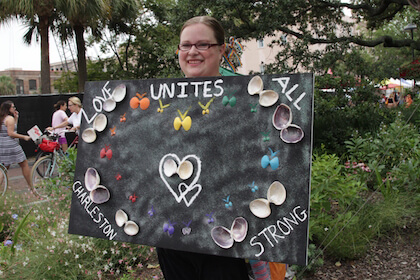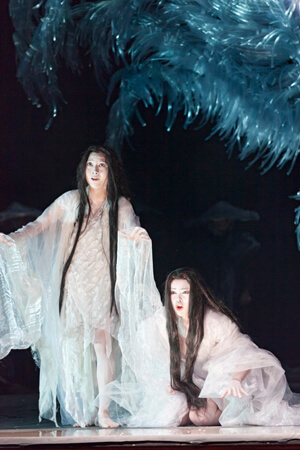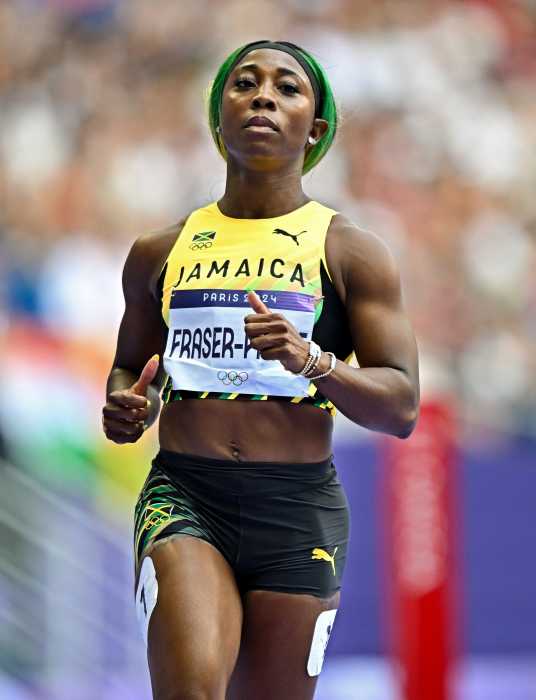Last week, a young white terrorist massacred nine African Americans in Charleston, South Carolina where the Confederate flag still flies over the State House. It’s time to pull it down. Not as a quick fix, but as one more step in the fight against racism.
Racism. What an inadequate word to explain these murders and the seemingly daily shootings of young black men (and women) at the hands of mostly white cops, our refusal to treat immigrants like humans, and the continuation of our policies treating Native Americans like the foreigners they aren’t.
White supremacy comes closer, a system enforced with constant propaganda and underlined with just enough good old fashioned terrorism to drive home the point that white folks are on top, everybody else is on the bottom, and you’ll stay there and like it if you don’t want to end up in a pool of your own blood.
A Dyke Abroad
But the consequences of this white supremacy are often not as visible as these deaths. And the cause is more complicated and rarely so conveniently displayed as the Confederate flag. Which begs the question, what do we do after it’s gone? Banned in public, will it become even more powerful in private spaces, fetishized by people like Dylann Storm Roof who will still have guns in their hands and still be vulnerable to messages of hate and resentment, which are easy enough to inscribe on their blank, ignorant lives?
Even if the symbol is removed, the worldview that kept it hanging there for so many years won’t go without a fight. Especially since the wolf managed to convince so many of us that it was nothing more than a lamb. The flag was a general symbol of rebellion. Slavery itself is increasingly portrayed as what? An inconvenience, really, for the slave.
Growing up in the parallel universe of white Kentucky, I didn’t even notice the stars and bars. You’d see it seasonally on the T-shirts and rusting cars of young white men who were just asserting their redneck class and independence. Don’t Tread on Me.
I remember drawing it with pleasure in red and blue crayons. If I had remained in Kentucky and not ventured out of my family circle, I might be one of those lamenting the loss of my heritage and clinging as tightly as I could to that ugly relic.
It never occurred to me that the flag had anything to do with defending slavery, or a willingness to recreate that system with violence and terror. All that seemed done and dusted, far from my tiny life trundling back and forth between my church and the school. Nobody even talked about racism. Black History hadn’t got its month yet, declaring falsely that slavery ended with the Emancipation Proclamation. Or maybe, Martin Luther King, Jr.
Equality was in the fact that black kids sat wherever they wanted in the lunchroom, no matter that there were only two or three among the 30 kids in the college prep courses I took. And all of us, I think, have been surprised to find out just how cleverly white supremacy could retrench itself in every aspect of our lives, from housing policy to health care.
In college at Transylvania University, I saw the Confederate flag hanging out the windows of the KA fraternity, and still thought of “The Dukes of Hazard,” not the KKK. When the frat boys dressed up in their rebel grays, greeting their sorority girlfriends decked out themselves in the dresses of Southern belles, I just thought they were all assholes. Not racists getting trained up to exercise their ideology behind closed doors, though that’s what it amounts to.
I had the leisure to forgot all about it, until I read “A Black Girl’s History with Southern Frat Racism,” a recent essay by Tracy Clayton, one of a small number of black students at Transy who succeeded in putting an end to the public display of the Confederate flag there. Despite being trained up by my years in New York, getting crash courses in race and tracking the violence against my own LGBT community, it was a kind of shock, an awakening to how blind I was then, and where ignorance could have taken me, but didn’t.
“Growing up in the hood, you assume that living where white folks live means safer streets and unlocked doors,” Clayton wrote. “But I never feared for my safety more than I did at Transylvania University. Those flags were often the first things I saw in the morning and the last things I saw at night, smugly watching me scurry to class, snickering, mocking. Well, I do declare! Look at that uppity coon, making like she belongs here, like she’s one of us. This is what happens when you teach ‘em to read. Hope that nigger makes it home before the sun goes down.”
For all those that didn’t make it in Charleston — #saytheirnames:
Reverend Clementa Pinckney, Reverend Sharonda Coleman-Singleton, Myra Thompson, Tywanza Sanders, Ethel Lee Lance, Cynthia Hurd, Reverend Daniel L. Simmons Sr., Reverend DePayne Middleton-Doctor, Susie Jackson.
Kelly Cogswell is the author of “Eating Fire: My Life as a Lesbian Avenger,” from the University of Minnesota.


































